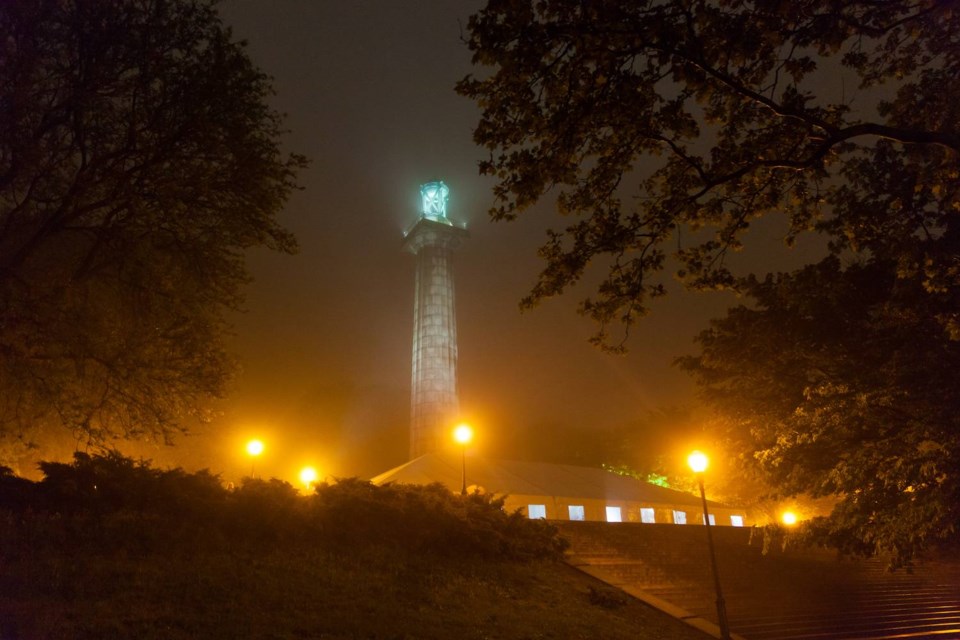Visitors to Fort Greene may notice the head of an obelisk, peeking above the trees surrounding Fort Greene Park.
A short climb up the hill reveals a 149-foot structure towering over the neighborhood. The base of the monument, with its quiet atmosphere and skyline views, has long been a common meeting place for local students and lifelong locals alike .
Cinephiles may recognize it from the iconic dance scene in Spike Lee's She's Gotta Have It (1986). The location has been an important backdrop in the lives of Brooklynites for over a century. But the courageous people this monument commemorates tend to be forgotten - but no longer.
On May 8, the Fort Greene Chapter of the Daughters of the American Revolution (DAR) hosted a walking tour highlighting the Prison Ship Martyrs. Over 11,500 men and women died aboard British Prison Ships in Wallabout Bay during the Revolutionary War. As they perished from overcrowded and unsanitary conditions, the British haphazardly buried them in shallow graves along the Brooklyn waterfront.
"These were thousands of men who died because they believed in independence - they believed in American independence" Alyssa Loorya, Ph.D, told BK Reader.
Loorya is a New York City historian and urban archaeologist. She led the tour from Jane's Carousel to the final resting place at Fort Greene Park. She narrated the history of the brave patriots while making several stops, as their remains did, across the Brooklyn Navy Yard.
This year, the Fort Greene Chapter of the DAR celebrates its 125th anniversary. Since 1896, the non-profit, non-political organization has been organized by women who are directly descended from American revolutionaries. They honor the legacy of their forebearers by preserving historical sites, supporting veterans, and educating current citizens on their stories through events like the walking tour.
"We come together because of our genealogy but we all have a shared sense of community and history" said Loorya.
The tour began at Jane's Carousel in Fulton Ferry. The shore's family-friendly atmosphere and scenic views are far removed from its violent past. It was from this point that George Washington's Army retreated to Manhattan, marking their defeat in the Battle of Long Island.
New York's revolutionary history is often buried amongst other stories from the centuries since the war. Philadelphia and Boston receive their due credit for the importance of those cities in the war effort. But the British occupation of New York was, in fact, the largest engagement of the entire war. More soldiers died as prisoners of war during the American Revolution than in actual combat.
"New York City has a fabulous history that goes back hundreds of years. It's easy to lose that history in the gloss and glamour of all the skyscrapers and international-class business" Loorya said.
Their choice of location for the crypt was a symbolic one. Fort Greene Park stands atop what was once Fort Putnam, a strategic defense position that was abandoned in General Washington's retreat to Manhattan. In 1873, the martyrs made their return to the fort as their remains were interred in a vault there until a proper memorial could be built.
The Fort Greene Chapter of the DAR was founded with the mission of building a memorial that suitably honored the sacrifices of those Americans who died in Wallabout Bay. Their triumphant moment came in 1909 when President William H. Taft dedicated the monument. McKinn, Mead, and White, the architectural firm responsible for New York's most grandiose American Renaissance style buildings, undertook design and construction.
The prisoners aboard the HMS Jersey truly earned their martyr status. Though they were given ample opportunities to defect to the crown, they instead chose to endure and ultimately die for the revolution.
"Overwhelmingly these offers were rejected because these men truly believed in America. That's part of the story because America belongs to everybody. They were descended from immigrants. Some of them were recent immigrants. And there were foreign nationals who fought on the side of independence," Loorya said.
The Ft. Greene chapter's aim was to create a conspicuous reminder of their die-hard principles. Today, that reminder is visible from half a mile down Willoughby Avenue. The monument challenges viewers to reach for the lofty ideals of the revolution with similar conviction to the men and women it is named for.
Membership to the DAR is open to any woman, regardless of race, ethnicity, or religion who can prove their lineage to an American revolutionary. Loorya and the rest of the Fort Greene chapter continue to steward the memory of the Prison Ship Martyrs and extol what their legacy means to Brooklyn and the United States as a whole.
"I'm a firm believer that in order to have a sustainable future we should have a well-understood past. All these bits and pieces of history: the Battle of Long Island, the Prison Ship Martyrs, the everyday people, and the founding fathers did not create America on their own. They're all part of our story."




